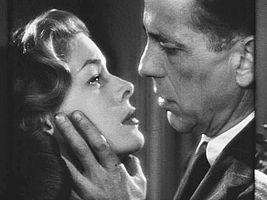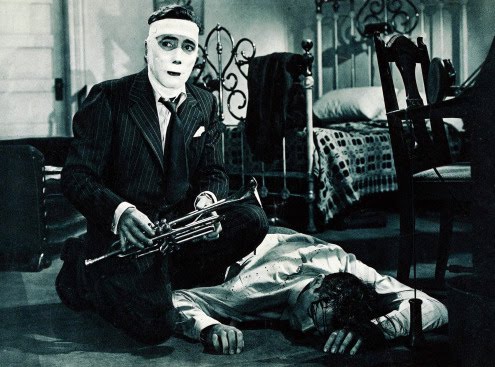Dark Passage/1947/Warner Bros./106 min.
I recently wrote about 1947’s “Lady in the Lake,” a Raymond Chandler/Philip Marlowe tale, starring and directed by Robert Montgomery. Its chief claim to fame is the experimental subjective camera – the story is told entirely from Marlowe’s point of view.
In that review, I noted that “Dark Passage,” starring Humphrey Bogart and Lauren Bacall, also from 1947, uses a subjective camera as well, though just for the first half-hour of the movie. The limited use of the technique in “Dark Passage” pays off much better than the full-on treatment in “Lady.” Though “Dark Passage” wasn’t a huge hit in its day – audiences weren’t crazy about being deprived of Bogart – it’s a film noir treasure that rarely gets its due.
Admittedly, the plausibility police would have a field day with this one. From the moment we meet Bogart as escaped San Quentin prisoner Vincent Parry and Bacall as Irene Jansen, his mysterious helper/wealthy benefactor, the phrase “never gonna happen” pops into your mind and lingers as the rather bizarre plot unfolds. This is not a realistic movie. So sue director/writer Delmer Daves and novelist David Goodis, who provided the source material.
I don’t think the filmmakers’ aim was to tell a story that’s relatable in a literal sense. The idea was to explore ideas about trust, identity, revenge, isolation and paranoia in the shell of an entertaining thriller that’s also infused with the famous Bogie-Bacall chemistry. At the same time, the sometimes-unwieldy narrative has depth and intelligence – it’s not merely a slapdash concoction of the outlandish and absurd. Goodis was a particularly pessimistic writer and a harsh social critic.
Here Bacall’s Irene is calling the shots, outwitting the cops and doling out shrewd suggestions to Vincent in her singular husky voice. Irene is the only person who believes in Vincent’s innocence –that he was wrongly convicted of murdering his wife. Dressed to elegant perfection in every scene, she spurs Vincent to spruce up his wardrobe as well. But Vincent needs more than a fashion overhaul if he is to avoid recapture.
Besides the leads, “Dark Passage” has a tremendous cast – Bruce Bennett shines as Irene’s solid, decent friend and the inimitable Agnes Moorehead sparkles as Madge, the ultimate conniving shrew, with a penchant for animal prints, no less. Houseley Stevenson is unforgettable as the unsavory but highly skilled Dr. Walter Coley. The creepy doctor proves pivotal in Vincent’s quest to remake himself. Even the small parts –a small-time crook, a chatty cabbie and a diner waiter (played by Clifton Young, Tom D’Andrea and Tom Fadden) – are great fun to watch.
The Franz Waxman score, along with San Francisco locations and slick cinematography by Sid Hickox, result in a noir rapture – including a nightmare sequence that is still unsettling 65 years later. Every detail of this strange little work, though not a great film, feels intriguing, satisfying and true to its own (slightly warped) logic.












From FNB readers